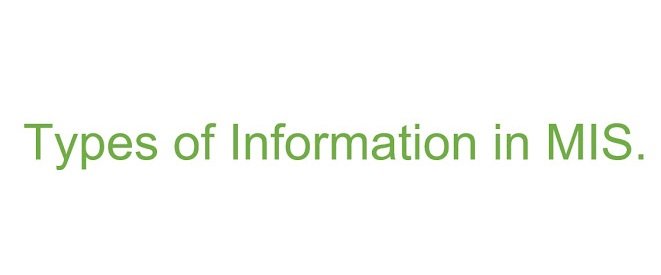Types of Information in MIS.
Information contains an element of surprise, reduces uncertainty and triggers off action, The information can be classified into three types :
1. Environmental Information :
Environmental information requirement can be further classified and described as follows:
- Government Policies : Information about government policies or financial and tax affairs, political stability, etc. is required and may have a significant effect on future planning decisions.
- Technological environment : The information on technological changes or advancements is necessary for forecasting such changes in the firm and their probable effects on the same. it is also desirable to access the effect of technical changes on new products and processes.
- Economic trends : It includes information about:
(a) Economic indicators like unemployment, productivity, capital investment;
(b) Prices and wages levels which affect all, regardless of product or services;
(c) GNP Levels, trend and consumer disposable income.
- Factors of production : These include information about the source, cost, location, availability, accessibility and productivity of the major factors of production such as labour, materials and spare parts as well as capital.
2. Competitive information :
Competitive information requirement can be classified and described as follows:
- (a) Industry Demand : This refers to the demand forecast of the industry for the product manufactured or about the area in which the firm is operating.
- (b) Firm demand : This implies assessment of the firm’s capabilities, activities and potentialities to meet demand relative to the capabilities and actions of the competing firms.
- (c) Competition : This includes information about competing firms for forecasting own product demand and making decisions and plans to achieve the forecast.
Such information falls into three categories :
(a) Past performance : It encompasses information concerning profitability, return on investment, market share etc. which helps to provide a yardstick for setting performance objectives for future.
(b) Present activity : Hence comes the information concerning competitor’s price strategies, advertising campaigns, product mix, changes in distribution channels, etc. which help to evaluate one’s own weaknesses or strengths.
(c) Future plans : Information concerning new products, R&D efforts, availability of raw materials, etc. Which help to decide future plans,comes under this head.
3. Internal Information :
It is the by-product of the normal operations of a business. Generally, it is historical or static in nature. Internal information is aimed at identification of the firm’s strengths and weaknesses. It includes the following:
- Policies : Long term basic policies on product range, marketing, finance and about personnel do not permit flexibility in developing alternative courses of action in the short run.
- Financial Plan : Information on financial or budget plan is important because it represents a quantitative and time bound commitment about the allocation of total resources like employees, plant, material, overheads, administrative expenses of the firm.
- Sales Forecast : Since all other internal plans of the firm are guided by the sales plan, it is considered as the dominant planning premise internal to the firm.
- Supply Factors : Information concerning availability and limitations of certain supply factors such as labour, capital, plant and equipment is important as these factors play a vital role in developing the financial and subsidiary plans for achieving, organization’s objectives.

